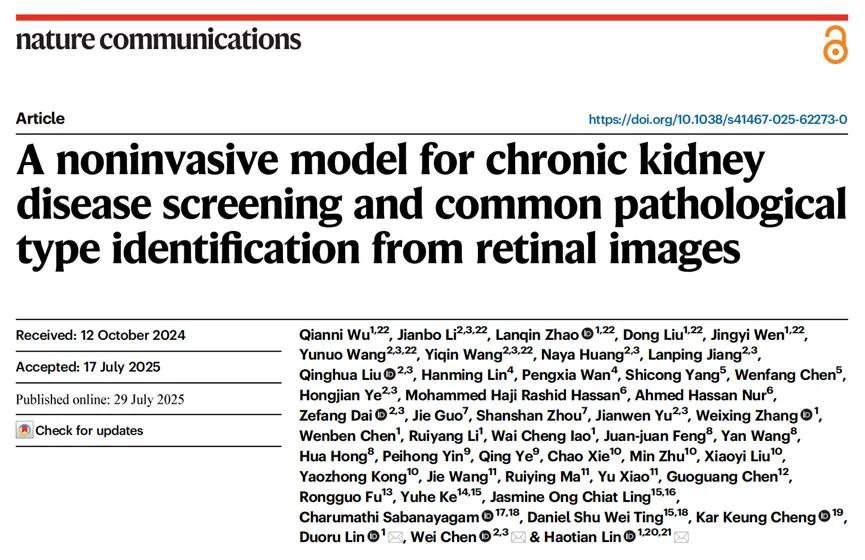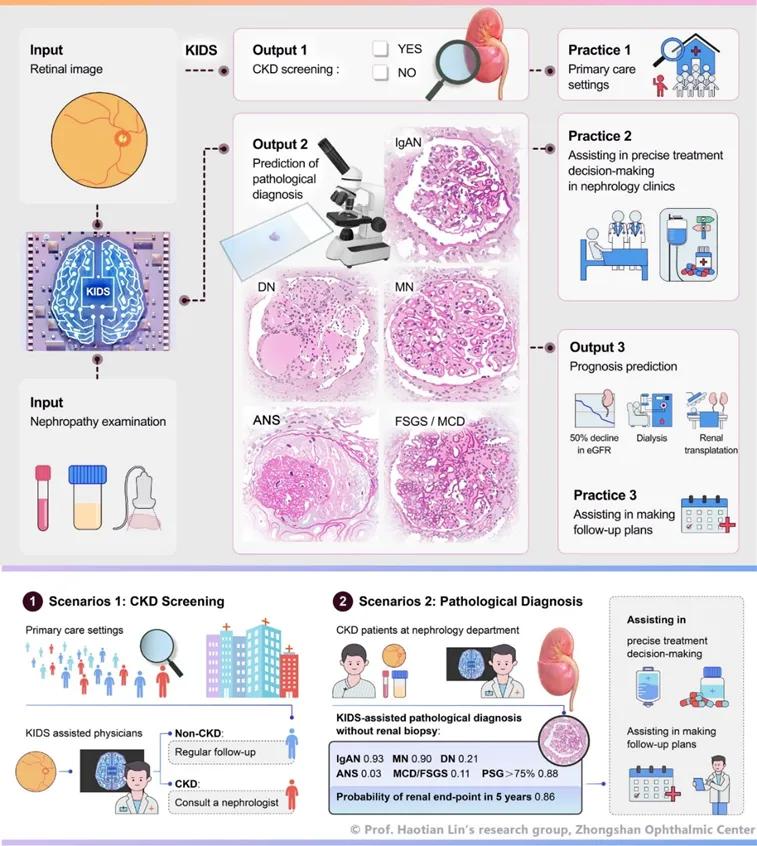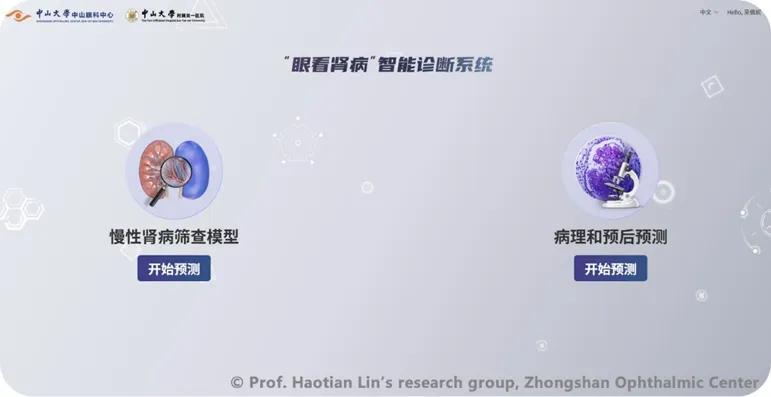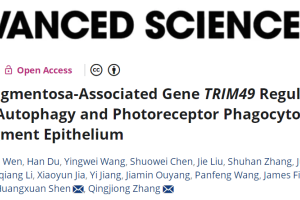
The eye is the only organ allowing direct observation of nerves and blood vessels in the human body, reflecting overall health. With the rapid development of ophthalmic imaging and artificial intelligence (AI) technologies, the eye is playing an increasingly vital role as a "window" for monitoring human health status.
Chronic Kidney Disease (CKD), due to its high prevalence, disability rate, and mortality rate, has become a major global public health problem. In May 2025, the World Health Organization (WHO) officially listed kidney disease as a major non-communicable disease of global priority concern. The prevalence of CKD in China is as high as 10.8%, but the awareness rate is only about 10%. Most patients are diagnosed only in the middle to late stages of the disease. It is projected that by 2032, the annual expenditure for CKD treatment in China will exceed 1.6 trillion yuan.
Accurate diagnosis and treatment of CKD rely on the "gold standard" of renal biopsy. However, renal biopsy is an invasive procedure. Its widespread adoption in underdeveloped regions and primary healthcare units is severely limited due to strict patient indications, high operator skill requirements, and the risk of complications. Therefore, developing innovative non-invasive kidney pathological diagnosis technology holds significant scientific value and clinical importance.
Research Findings
To address this major challenge, a research team led by Prof. Lin Haotian from Zhongshan Ophthalmic Center (ZOC) of Sun Yat-sen University (SYSU) and Prof. Chen Wei from the Department of Nephrology at SYSU's First Affiliated Hospital initiated the establishment of the "Intelligent Eye-Kidney Alliance" (iEKA) in July 2021. This alliance brought together multiple hospitals domestically and internationally to promote the innovative application of AI technology based on ocular images in kidney disease management. The team collected 13,144 fundus images and developed a multimodal machine learning model, creating a non-invasive intelligent kidney disease diagnosis system based on color fundus photographs called KIDS (Kidney Intelligent Diagnosis System). KIDS was validated in multiple centers, including the Guangdong-Hong Kong-Macao Greater Bay Area, Xinjiang, and Somalia, Africa. By inputting a patient's fundus image, KIDS achieves three core functions: early CKD screening, non-invasive pathological diagnosis, and prognosis prediction, covering the entire disease management process.
On July 29, 2025, the research findings were published online in Nature Communications under the title "A noninvasive model for chronic kidney disease screening and common pathological type identification from retinal images." The technology has also been granted one invention patent. This provides technical support for kidney disease screening and precision management in underdeveloped regions and primary healthcare institutions, while also offering a new model for the co-management of eye and kidney diseases.

Research paper published online in Nature Communications on July 29, 2025
1. CKD Screening
By inputting a subject's fundus image, KIDS can intelligently identify whether they have CKD and also excels at identifying different stages of CKD (AUC: 0.839–0.993). This facilitates large-scale early screening and risk prediction, prompting high-risk individuals to seek specialized nephrology care promptly, thereby promoting the early detection, diagnosis, and intervention of CKD. It is suitable for community hospitals, primary healthcare institutions, and health examination centers.
2. Non-invasive Pathological Diagnosis of CKD
When a CKD patient visits a nephrology or general internal medicine department, doctors can input the patient's fundus image into KIDS, with or without routine blood and urine test results. KIDS then predicts the probability of the patient having common pathological types such as IgA Nephropathy, Primary Membranous Nephropathy, Diabetic Nephropathy, Hypertensive Renal Damage, and Minimal Change Disease (MCD)/Focal Segmental Glomerulosclerosis (FSGS) (AUC: 0.790–0.932). It can simultaneously predict the probability of pathological glomerulosclerosis exceeding 75% (AUC: 0.883–0.919).
In multicenter human-machine comparison tests, KIDS achieved an average diagnostic accuracy 26.89% higher than nephrology specialists, demonstrating significant superiority. Therefore, KIDS can provide reliable non-invasive pathological diagnosis for patients who have not undergone or cannot undergo renal biopsy, assisting clinicians in formulating individualized treatment plans and promoting precision management of CKD. It is suitable for nephrology or internal medicine departments in general hospitals.
3. CKD Prognosis Prediction
The KIDS system can also predict the risk of CKD patients experiencing renal endpoint events (including eGFR decline ≥50%, progression to End-Stage Renal Disease (ESRD), and initiation of Renal Replacement Therapy) within the next 5 years, with good predictive performance (C-index: 0.811). This function helps doctors develop personalized follow-up and management strategies, identify high-risk groups early, strengthen interventions, and reduce the likelihood of adverse outcomes.

KIDS assists doctors in chronic kidney disease screening, pathological diagnosis, and prognosis prediction
Furthermore, addressing the severe shortage of medical resources and limited access to renal biopsy in underdeveloped regions like Somalia, Africa, the research team developed a simplified version of the KIDS model. This lightweight model relies only on limited blood and urine test indicators to achieve relatively accurate prediction of CKD pathological types. In real-world validation datasets from multiple centers domestically and internationally, this simplified model still demonstrated good stability and generalization ability, with a prediction performance AUC as high as 0.952, fully showcasing its broad application prospects in underdeveloped regions.
Currently, KIDS has been deployed on the ZOC Intelligent Ophthalmic Diagnosis Cloud Platform. It is undergoing clinical application and real-world validation studies in multiple centers both within China and internationally. It is expected to significantly improve the accuracy of early CKD screening and diagnosis, as well as the level of precision treatment. This innovative achievement is moving "from the bookshelf to the shelf" (from concept to practical application). It not only fills the technological gap in non-invasive intelligent diagnosis of multi-pathological type CKD but also provides key technical support for achieving the chronic disease whole-cycle health management goals outlined in the "Healthy China 2030" strategy. In the future, the team will further promote the implementation of KIDS in a wider range of primary healthcare institutions, pioneering a new model of "seeing" kidney diseases through the eyes to enhance the prevention and control level of chronic kidney disease in China.

KIDS Intelligent Diagnosis Cloud Platform
Introduction to the Collaborative Research Teams
1. Prof. Lin Haotian's Team, Zhongshan Ophthalmic Center, Sun Yat-sen University
Prof. Lin Haotian's team at ZOC collaborates with universities and research institutions domestically and internationally. Leveraging interdisciplinary strengths, they have established an ophthalmic AI diagnosis, treatment, and clinical application system. They further innovate algorithms based on ocular features to drive breakthroughs in intelligent screening and diagnosis technologies for eye and systemic diseases, exploring new models for managing systemic diseases "seen" through the eyes. They have constructed a novel intelligent "three-tiered diagnosis and treatment" model for eye diseases, enabling multi-scenario application of eye disease diagnosis and treatment. Related technological achievements have been widely applied in representative medical institutions across China and in countries and regions along the "Belt and Road," benefiting millions of residents and patients. They lead the innovation and development of key intelligent technologies for eye disease prevention and treatment capabilities, enhancing the level of eye disease prevention and treatment.
The team has led major national research projects (excellently concluded), Key Projects under the Major Research Plan of the National Natural Science Foundation of China, and major disease smart diagnosis and treatment projects. They have published over 200 papers in top international journals including Nature, Nature Medicine, Nature Biomedical Engineering, and Lancet Digital Health, obtained 47 domestic and international patents, 12 software copyrights, with 5 technologies transferred and applied.
2. Prof. Chen Wei's Team, The First Affiliated Hospital, Sun Yat-sen University
Prof. Chen Wei is the Director of the Department of Internal Medicine, Director of the Department of Nephrology, and Director of the National Health Commission Key Laboratory of Clinical Research on Kidney Disease at SYSU's First Affiliated Hospital. She also serves as the Vice Chairman of the Chinese Society of Nephrology. She has long been dedicated to basic and clinical translational research on the precise prevention and treatment of chronic kidney disease. Her team has significant advantages in immune-related kidney diseases (Lupus Nephritis, IgA Nephropathy), peritoneal dialysis, and smart healthcare.
She has led 16 scientific research projects at various levels, including 5 National Natural Science Foundation projects and 1 key project under the National Key R&D Program. She has published 85 SCI papers as first author/corresponding author in international professional journals such as Immunity, Annals of the Rheumatic Diseases, Kidney International, Advanced Science, and JAMA Network Open.
3. Paper Authors
This study was completed jointly by the team of Prof. Lin Haotian (Director of the State Key Laboratory of Ophthalmology, ZOC) and the team of Prof. Chen Wei from SYSU's First Affiliated Hospital.
Dr. Wu Qianni (ZOC), Associate Chief Physician Li Jianbo (First Affiliated Hospital), Assistant Researcher Zhao Lanqin (ZOC), Associate Researcher Liu Dong (ZOC), Postdoctoral Fellow Wen Jingyi (ZOC), Attending Physician Wang Yunuo (First Affiliated Hospital), and Postdoctoral Fellow Wang Yiqin (First Affiliated Hospital) are the co-first authors. Prof. Lin Haotian (ZOC), Prof. Chen Wei (First Affiliated Hospital), and Associate Researcher Lin Duoru (ZOC) are the co-corresponding authors. Zhongshan Ophthalmic Center of Sun Yat-sen University / the State Key Laboratory of Ophthalmology is the first affiliation.
This study also received substantial support and assistance from numerous hospitals and expert teams domestically and internationally, including Zhongshan People's Hospital, Foshan First People's Hospital, Affiliated Hospital of Youjiang Medical University for Nationalities, Kashgar Prefecture First People's Hospital, The Second Affiliated Hospital of Xi'an Jiaotong University, Shanxi Research Institute of Traditional Chinese Medicine, and Banadir Hospital in Somalia, Africa.
4. Link to the Original Paper
https://www.nature.com/articles/s41467-025-62273-0











